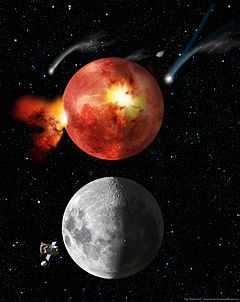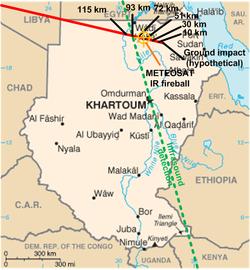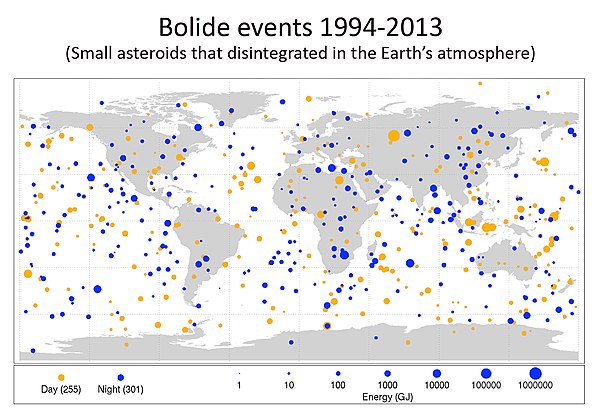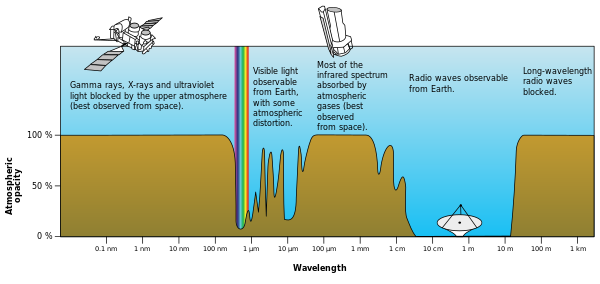Artist's impression of the Moon during the Late Heavy Bombardment (above) and today (below).
The Late Heavy Bombardment (abbreviated LHB and also known as the lunar cataclysm) is an event thought to have occurred approximately 4.1 to 3.8 billion years (Ga) ago, at a time corresponding to the Neohadean and Eoarchean eras on Earth. During this interval, a disproportionately large number of asteroids are theorized to have collided with the early terrestrial planets in the inner Solar System, including Mercury, Venus, Earth, and Mars.
The Late Heavy Bombardment happened after the Earth and other rocky planets had formed and accreted most of their mass, but still quite early in Earth's history.
Evidence for the LHB derives from lunar samples brought back by the Apollo astronauts. Isotopic dating of Moon
rocks implies that most impact melts occurred in a rather narrow
interval of time. Several hypotheses attempt to explain the apparent
spike in the flux of impactors (i.e. asteroids and comets) in the inner Solar System, but no consensus yet exists. The Nice model, popular among planetary scientists, postulates that the giant planets underwent orbital migration and in doing so, scattered objects in the asteroid and/or Kuiper belts
into eccentric orbits, and into the path of the terrestrial planets.
Other researchers argue that the lunar sample data do not require a
cataclysmic cratering event near 3.9 Ga, and that the apparent
clustering of impact-melt ages near this time is an artifact of sampling
materials retrieved from a single large impact basin.
They also note that the rate of impact cratering could differ
significantly between the outer and inner zones of the Solar System.
Evidence for a cataclysm
The main piece of evidence for a lunar cataclysm comes from the radiometric ages
of impact melt rocks that were collected during the Apollo missions.
The majority of these impact melts are believed to have formed during
the collision of asteroids or comets tens of kilometres across, forming
impact craters hundreds of kilometres in diameter. The Apollo 15, 16, and 17 landing sites were chosen as a result of their proximity to the Imbrium, Nectaris, and Serenitatis basins, respectively.
The apparent clustering of ages of these impact melts, between
about 3.8 and 4.1 Ga, led to postulation that the ages record an intense
bombardment of the Moon.
They called it the "lunar cataclysm" and proposed that it represented a
dramatic increase in the rate of bombardment of the Moon around 3.9 Ga.
If these impact melts were derived from these three basins, then not
only did these three prominent impact basins form within a short
interval of time, but so did many others based on stratigraphic grounds. At the time, the conclusion was considered controversial.
As more data has become available, particularly from lunar meteorites,
this theory, while still controversial, has gained in popularity. The
lunar meteorites are believed to randomly sample the lunar surface, and
at least some of these should have originated from regions far from the
Apollo landing sites. Many of the feldspathic
lunar meteorites probably originated from the lunar far side, and
impact melts within these have recently been dated. Consistent with the
cataclysm hypothesis, none of their ages was found to be older than
about 3.9 Ga. Nevertheless, the ages do not "cluster" at this date, but span between 2.5 and 3.9 Ga.
Dating of howardite, eucrite and diogenite (HED) meteorites and H chondrite
meteorites originating from the asteroid belt reveal numerous ages from
3.4–4.1 Ga and an earlier peak at 4.5 Ga. The 3.4–4.1 Ga ages has been
interpreted as representing an increase in impact velocities as computer
simulations using hydrocode reveal that the volume of impact melt
increases 100–1,000 times as the impact velocity increases from the
current asteroid belt average of 5 km/s to 10 km/s. Impact velocities
above 10 km/s require very high inclinations or the large eccentricities
of asteroids on planet crossing orbits. Such objects are rare in the
current asteroid belt but the population would be significantly
increased by the sweeping of resonances due to giant planet migration.
Studies of the highland crater size distributions suggest that
the same family of projectiles struck Mercury and the Moon during the Late Heavy Bombardment.
If the history of decay of late heavy bombardment on Mercury also
followed the history of late heavy bombardment on the Moon, the youngest
large basin discovered, Caloris,
is comparable in age to the youngest large lunar basins, Orientale and
Imbrium, and all of the plains units are older than 3 billion years.
Criticisms of the cataclysm hypothesis
While
the cataclysm hypothesis has recently gained in popularity,
particularly among dynamicists who have identified possible causes for
such a phenomenon, the cataclysm hypothesis is still controversial and
based on debatable assumptions. Two criticisms are that (1) the
"cluster" of impact ages could be an artifact of sampling a single
basin's ejecta, and (2) that the lack of impact melt rocks older than
about 4.1 Ga is related to all such samples having been pulverized, or
their ages being reset.
The first criticism concerns the origin of the impact melt rocks
that were sampled at the Apollo landing sites. While these impact melts
have been commonly attributed to having been derived from the closest basin, it has been argued that a large portion of these might instead be derived from the Imbrium basin.
The Imbrium impact basin is the youngest and largest of the multi-ring
basins found on the central nearside of the Moon, and quantitative
modeling shows that significant amounts of ejecta from this event should
be present at all of the Apollo landing sites. According to this
alternative hypothesis, the cluster of impact melt ages near 3.9 Ga
simply reflects material being collected from a single impact event,
Imbrium, and not several. Additional criticism also argues that the age
spike at 3.9 Ga identified in 40Ar/39Ar dating could also be produced by
an episodic early crust formation followed by partial 40Ar losses as
the impact rate declined.
A second criticism concerns the significance of the lack of
impact melt rocks older than about 4.1 Ga. One hypothesis for this
observation that does not involve a cataclysm is that old melt rocks did
exist, but that their ages have all been reset by the continuous
effects of impact cratering over the past 4 billion years. Furthermore,
it is possible that these putative samples could all have been
pulverized to such small sizes that it is impossible to obtain age
determinations using standard radiometric methods.
Latest reinterpretation of crater statistics suggests that the flux on
the Moon and on Mars may have been lower in general. Thus, the recorded
crater population can be explained without any peak in the earliest
bombardment of the inner Solar System.
Geological consequences on Earth
If a cataclysmic cratering event truly occurred on the Moon, the Earth would have been affected as well. Extrapolating lunar cratering rates to Earth at this time suggests that the following number of craters would have formed:
- 22,000 or more impact craters with diameters >20 km (12 mi),
- about 40 impact basins with diameters about 1,000 km (620 mi),
- several impact basins with diameters about 5,000 km (3,100 mi),
Before the formulation of the LHB theory, geologists generally
assumed that the Earth remained molten until about 3.8 Ga. This date
could be found in many of the oldest-known rocks
from around the world, and appeared to represent a strong "cutoff
point" beyond which older rocks could not be found. These dates remained
fairly constant even across various dating methods, including the
system considered the most accurate and least affected by environment, uranium–lead dating of zircons.
As no older rocks could be found, it was generally assumed that the
Earth had remained molten until this date, which defined the boundary
between the earlier Hadean and later Archean
eons. Nonetheless, more recently, in 1999, the oldest known rock on
Earth was dated to be 4.031 ± 0.003 billion years old, and is part of
the Acasta Gneiss of the Slave Craton in northwestern Canada.
Older rocks could be found, however, in the form of asteroid fragments that fall to Earth as meteorites.
Like the rocks on Earth, asteroids also show a strong cutoff point, at
about 4.6 Ga, which is assumed to be the time when the first solids
formed in the protoplanetary disk
around the then-young Sun. The Hadean, then, was the period of time
between the formation of these early rocks in space, and the eventual
solidification of the Earth's crust, some 700 million years later. This
time would include the accretion of the planets from the disk and the
slow cooling of the Earth into a solid body as the gravitational
potential energy of accretion was released.
Later calculations showed that the rate of collapse and cooling
depends on the size of the rocky body. Scaling this rate to an object of
Earth mass suggested very rapid cooling, requiring only 100 million
years. The difference between measurement and theory presented a conundrum at the time.
The LHB offers a potential explanation for this anomaly. Under
this model, the rocks dating to 3.8 Ga solidified only after much of the
crust was destroyed by the LHB. Collectively, the Acasta Gneiss in the North American cratonic shield and the gneisses within the Jack Hills
portion of the Narryer Gneiss Terrane in Western Australia are the
oldest continental fragments on Earth, yet they appear to post-date the
LHB. The oldest mineral yet dated on Earth, a 4.404 Ga zircon from Jack
Hills, predates this event, but it is likely a fragment of crust left
over from before the LHB, contained within a much younger (~3.8 Ga old)
rock.
The Jack Hills zircon led to something of a revolution in our understanding of the Hadean eon. Older references generally show that Hadean Earth had a molten surface with prominent volcanos. The name "Hadean" itself refers to the "hellish" conditions assumed on Earth for the time, from the Greek Hades.
Zircon dating suggested, albeit controversially, that the Hadean
surface was solid, temperate, and covered by acidic oceans. This picture
derives from the presence of particular isotopic ratios that suggest
the action of water-based chemistry at some time before the formation of
the oldest rocks (see Cool early Earth).
Of particular interest, Manfred Schidlowski argued in 1979 that the carbon isotopic ratios of some sedimentary rocks found in Greenland
were a relic of organic matter. There was much debate over the precise
dating of the rocks, with Schidlowski suggesting they were about 3.8 Ga
old, and others suggesting a more "modest" 3.6 Ga. In either case it was
a very short time for abiogenesis to have taken place, and if Schidlowski was correct, arguably too short a time. The Late Heavy Bombardment and the "re-melting" of the crust that it suggests provides a timeline under which this would be possible; life either formed immediately after the Late Heavy Bombardment, or more likely survived it, having arisen earlier during the Hadean.
Recent studies suggest that the rocks Schidlowski found are indeed from
the older end of the possible age range at about 3.85 Ga, suggesting
the latter possibility is the most likely answer.
More recent studies have found no evidence for the isotopically light
carbon ratios that were the basis for the original claims.
More recently, a similar study of Jack Hills rocks shows traces
of the same sort of potential organic indicators. Thorsten Geisler of
the Institute for Mineralogy at the University of Münster
studied traces of carbon trapped in small pieces of diamond and
graphite within zircons dating to 4.25 Ga. The ratio of carbon-12 to
carbon-13 was unusually high, normally a sign of "processing" by life.
Three-dimensional computer models developed in May 2009 by a team at the University of Colorado at Boulder
postulate that much of Earth's crust, and the microbes living in it,
could have survived the bombardment. Their models suggest that although
the surface of the Earth would have been sterilized, hydrothermal vents below the Earth's surface could have incubated life by providing a sanctuary for heat-loving microbes.
In April 2014, scientists reported finding evidence of the largest terrestrial meteor impact event to date near the Barberton Greenstone Belt.
They estimated the impact occurred about 3.26 billion years ago and
that the impactor was approximately 37 to 58 kilometres (23 to 36 miles)
wide. The crater from this event, if it still exists, has not yet been
found.
Possible causes
Giant-planet migration
Simulation
showing outer planets and planetesimal belt: a) Early configuration,
before Jupiter (green) and Saturn (orange) reach 2:1 resonance b)
Scattering of planetesimals into the inner Solar System after the
orbital shift of Neptune (dark blue) and Uranus (light blue) c) After
ejection of planetesimals by planets.
In the Nice model the Late Heavy Bombardment is the result of a
dynamical instability in the outer Solar System. The original Nice model
simulations by Gomes et al. began with the Solar System's giant planets in a tight orbital configuration surrounded by a rich trans-Neptunian belt.
Objects from this belt stray into planet crossing orbits causing the
orbits of the planets to migrate over several hundred million years.
Jupiter and Saturn's orbits drift apart slowly until they cross a 2:1 orbital resonance causing the eccentricities
of their orbits to increase. The orbits of the planets become unstable
and Uranus and Neptune are scattered onto wider orbits that disrupt the
outer belt, causing a bombardment of comets as they enter planet
crossing orbits. Interactions between the objects and the planets also
drive a faster migration of Jupiter and Saturn's orbits. This migration
causes resonances to sweep through the asteroid belt, increasing the
eccentricities of many asteroids until they enter the inner Solar System
and impact the terrestrial planets.
The Nice model has undergone some modification since its initial
publication. The giant planets now begin in a multi-resonant
configuration due an early gas-driven migration through the
protoplanetary disk. Interactions with the trans-Neptunian belt allow their escape from the resonances after several hundred million years. The encounters between planets that follow include one between an ice giant
and Saturn the that propels the ice giant onto a Jupiter-crossing orbit
followed by an encounter with Jupiter which drives the ice giant
outward. This jumping-Jupiter scenario
quickly increases the separation of Jupiter and Saturn, limiting the
effects of resonance sweeping on the asteroids and the terrestrial
planets.
While this is required to preserve the low eccentricities of the
terrestrial planets and avoid leaving the asteroid belt with too many
high eccentricity asteroids, it also reduces the fraction of asteroids
removed from the main asteroid belt, leaving a now nearly depleted inner band of asteroids as the primary source of the impactors of the LHB. The ice giant is often ejected following its encounter with Jupiter leading some to propose that the Solar System began with five giant planets.
Recent works, however, have found that impacts from this inner asteroid
belt would be insufficient to explain the formation of ancient impact
spherule beds and the lunar basins, and that the asteroid belt was probably not the source of the Late Heavy Bombardment.
Late Uranus/Neptune formation
According to one planetesimal
simulation of the establishment of the planetary system, the outermost
planets Uranus and Neptune formed very slowly, over a period of several
billion years.
Harold Levison and his team have also suggested that the relatively low
density of material in the outer Solar System during planet formation
would have greatly slowed their accretion.
This "late appearance" of these planets has therefore been suggested as a
different reason for the LHB. However, recent calculations of gas-flows
combined with planetesimal runaway growth in the outer Solar System
imply that Jovian planets formed extremely rapidly, on the order of 10 My, which does not support this explanation for the LHB.
Planet V hypothesis
The Planet V hypothesis posits that a fifth terrestrial planet created the Late Heavy Bombardment
when its meta-stable orbit entered the inner asteroid belt. The
hypothetical fifth terrestrial planet, Planet V, had a mass less than
half of Mars and originally orbited between Mars and the asteroid belt.
Planet V's orbit became unstable due to perturbations from the other
inner planets causing it to intersect the inner asteroid belt. After
close encounters with Planet V, many asteroids entered Earth-crossing
orbits producing the Late Heavy Bombardment. Planet V was
ultimately lost, likely plunging into the Sun. In numerical simulations,
an uneven distribution of asteroids, with the asteroids heavily
concentrated toward the inner asteroid belt, has been shown to be
necessary to produce the LHB via this mechanism.
An alternate version of this hypothesis in which the lunar impactors
are debris resulting from Planet V impacting Mars, forming the Borealis Basin,
has been proposed to explain a low number of giant lunar basins
relative to craters and a lack of evidence of cometary impactors.
Disruption of Mars-crossing asteroid
A
hypothesis proposed by Matija Ćuk posits that the last few
basin-forming impacts were the result of the collisional disruption of a
large Mars-crossing asteroid. This Vesta-sized
asteroid was a remnant of a population which initially was much larger
than the current main asteroid belt. Most of the pre-Imbrium impacts
would have been due to these Mars-crossing objects, with the early
bombardment extending until 4.1 billion years ago. A lull in
basin-forming impacts then followed during which the lunar magnetic
field decayed. Then roughly 3.9 billion years ago a catastrophic impact
disrupted the Vesta-sized asteroid radically increasing the population
of Mars-crossing objects. Many of these objects then evolved onto
Earth-crossing orbits producing a spike in the lunar impact rate during
which the last few lunar impact basins are formed. Ćuk points to the
weak or absent residual magnetism of the last few basins and a change in
the size-frequency distribution of craters which formed during this
late bombardment as evidence supporting this hypothesis. The timing and the cause of the change in the size-frequency distribution of craters is controversial.
Other potential sources
A number of other possible sources of the Late Heavy Bombardment
have been investigated. Among these are additional Earth satellites
orbiting independently or as lunar trojans, planetesimals left over from
the formations of the terrestrial planets, Earth or Venus co-orbitals,
and the breakup of a large main belt asteroid. Additional Earth
satellites on independent orbits were shown to be quickly captured into
resonances during the Moon's early tidally-driven orbital expansion and
were lost or destroyed within in a few million years Lunar trojans were found to be destabilized within 100 million years by a solar resonance when the Moon reached 27 Earth radii.
Planetesimals left over from the formation of the terrestrial planets
were shown to be depleted too rapidly due to collisions and ejections to
form the last lunar basins.
The long-term stability of primordial Earth or Venus co-orbitals
(trojans or objects with horseshoe orbits) in conjunction with the lack
of current observations indicate that they were unlikely to have been
common enough to contribute to the LHB.
Producing the LHB from the collisional disruption of a main belt
asteroid was found to require at minimum a 1,000–1,500 km parent body
with the most favorable initial conditions. Debris produced by collisions among inner planets, now lost, has also been proposed as a source of the LHB.
Exosystem with possible Late Heavy Bombardment
Evidence has been found for Late Heavy Bombardment-like conditions around the star Eta Corvi.










